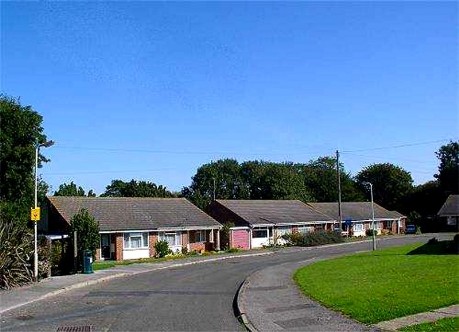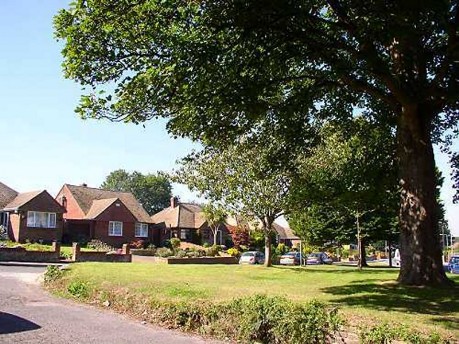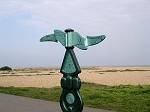Walmer's Past
A History of Nevill Gardens, Upper Walmer
The following article on the area around the Nevill Gardens cul-de-sac at Upper Walmer was compiled by local resident Mike Hirst with the help of Graham Turner, Fred Wells, Irene Carroll, Terry Dunn, Jim Collett, Hilda Ryan and several others.

Nevill Gardens, Upper Walmer

Station Road, Upper Walmer
On 1 March 1920, a parcel of land between Church Street and Station Road was purchased by Violet Mary TURNER from Frederick Wingfield LEITH. The purchase was of approximately 4½ acres and included a walled-in area (Pond Pasture) and an open area (Nevill Gardens).
During the 1920's the land was developed in various ways.
Benjamin George TURNER built a bungalow (numbered 20, Station Road) which was situated approximately on the roadward side of what is now "The Firs".
An orchard was created on part of the open area growing apples and pears.
Within the walled area a vegetable garden was established, also a nature area. Originally there was a pond with a small island but the pond dried up in the 1920's.
A Tennis Court and Pavilion were built on the southern side of the wall on what is now 1 to 6 Nevill Gardens.
On 30 April 1934, Miss Kathleen TURNER planted a "Quercus robur" (English Oak) as an early celebration of the Silver Jubilee of King George V. This tree still stands in the garden of 9 Nevill Gardens.
On 14 December 1953, Violet Mary TURNER sold the land to Herbert Milton BARKER. He died shortly afterwards and the land was re-purchased by the TURNER family who had by this time moved to Dover. The orchard and vegetable garden continued to be maintained and the bungalow was rented out.
In 1963, Benjamin George TURNER obtained Planning Permission to build "Pond Pasture" in the walled-in area. B.G. TURNER had decided on the name some years earlier and in the intervening years purchased a supply of Dutch bricks and Kent Peg tiles which were used in the building of "Pond Pasture". Unfortunately he died but his son completed the building. Initially Pond Pasture was rented out but eventually sold to Anthony William and Valerie Ann HEDGER.
The bungalow at 20 Station Road was burnt down by vandals when it was unoccupied during the early 1970's.
On 11 October 1972, the land (Nevill Gardens) was sold by Anthony William and Valerie Ann HEDGER to Graham Peverell and George Nevill TURNER. William HEDGER retained Pond Pasture.
In 1973 (approx) Graham TURNER obtained a parcel of land which joined his property with Station Road from Geoffrey MOORE. This land was needed for "sight lines" for the development he was planning. In return Geoffrey MOORE obtained the parcel of land that is now "Tudor Lodge".
During 1973/74 Graham TURNER arranged "Outline Planning Permission" and at this stage the Council asked for suggestions for a name and it was decided to call it "Nevill Gardens" after George NEVILL TURNER who was the first person born on that land in 1935.
The site was sold to the Greater London Council In the early 1970's, but two portions of land were retained by Graham TURNER:-
(1) To the South West (the current 20 Station Road)(2) Land to the North East between the wall of Pond Pasture and the rear gardens of 1 to 6 Nevill Gardens. Graham TURNER sold this land to Anthony Hedger, the then owner of Pond Pasture.During the later 1970's Nevill Gardens lay fallow. The GLC applied for and obtained "Detailed Planning Permission" for the site.
The construction of the 14 bungalows must have started in 1979/80. It is said that several builders suffered financial problems while working on the site due to the GLC's slowness in settling accounts.
The original plan by the GLC appears to have been a bit of "property speculation" because prospective buyers were bussed to the site. It seems that the asking price of £25,000 was thought too high. The uptake of sales must have been disappointing as only six bungalows (nos 2, 3, 4, 6, 8 and 9) were sold. The remaining eight bungalows were then offered to existing London Borough tenants, one condition being that they must be over 60 years of age.
The first owner/occupiers moved in during January 1981. The first tenants moved in during August 1981.
In 1981 the plot upon which the current 20 Station Road is built was purchased by DW Construction from Worsfold & Co (Estate Agents). This land originally housed the garages which were associated with the bungalow (the original 20 Station Road) and had been retained by Graham TURNER (who owned Worsfold & Co) . Dave HOLOBAN (DW Construction) built the existing 20 Station Road on the site.
In 1985 the plot on which "Millstone" is built was purchased from the Church Commissioners by John HALL who built "Millstone". Arthur and Christine LIVERSIDGE bought it and moved during July 1986.
In 1986 the GLC was abolished by the Government and at this stage North British Housing took over the management of the eight bungalows.
On 7 March 1986, Fred WELLS purchased part of the garden of 26 Station Road from Mr and Mrs Benson. On this land he built two houses. The first was "Ashwell" (now called "Willowdene"). Fred WELLS built "Ashwell" in 1987 and lived in it for 14 years. "The Firs" was built in 1988 and Mrs Betty BICKERTON bought it and moved in during 1989.
In 1987 the plot of land (now "Tudor Lodge") was purchased by Dave EASTON from Geoffrey MOORE. Dave EASTON built, named and lived in Tudor Lodge for over 10 years.
The mother of comedian Sir Norman WISDOM lived in 10 Station Road (dates unknown) and moved to Grams Road in the early 1960's.

